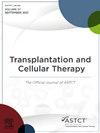Umbilical Cord Blood Reduced Relapse but Increased Nonrelapse Mortality Compared to Matched Unrelated Donor Transplantation in Pediatric Acute Myeloid Leukemia With Active Disease: A CIBMTR 2008 to 2017 Analysis of Donor Source and Residual Disease
IF 3.6
3区 医学
Q2 HEMATOLOGY
引用次数: 0
Abstract
Umbilical cord blood (UCB) and matched unrelated donors (MUD) are common alternative donor options in children with high-risk acute myeloid leukemia (AML). Emerging evidence suggests an augmented graft-versus-leukemia (GVL) effect of UCB, but uncertainties persist due to the heterogeneity of the hematopoietic cell transplantation (HCT) characteristics in the previous studies. We reviewed 1148 patients aged ≤18 years with AML, who underwent the first HCT between 2008 to 2017, using a publicly available dataset from the Center for International Blood and Marrow Transplantation Research (CIBMTR) registry data. Multivariable analyses evaluated predictors of DFS and other clinical outcomes, factoring in graft source, conditioning regimen, patient age, cytogenetic risk, and HCT year (significance at P < .01). Residual disease status was assessed both as a covariate and as a stratifying factor. Additionally, the differential effects of conditioning regimens were analyzed specifically within the UCB cohort. UCB was used most frequently (33.8%) followed by MUD (29.1%), both of which had comparable DFS and overall survival. In patients with minimal residual disease or not in remission prior to HCT, human-leukocyte antigen (HLA) ≤5/8 matched UCB was associated with lower relapse rates than MUD (hazard risk [HR]: 0.25 and 0.29, P = .005 and .006, respectively) but with increased nonrelapse mortality (HR: 32.8 and 7.5, P = .001 and .012, respectively). Conditioning regimens varies by graft type; total body irradiation (TBI)-based regimens, primarily combined with cyclophosphamide and fludarabine, were more common in the UCB cohort (45% in UCB versus 19% in the other grafts, P < .001). Within the 388 patients received UCB, multivariable analysis demonstrated comparable DFS and OS across variable busulfan- and TBI-based regimens, with no trend of superiority for either approach. In conclusion, highly HLA-mismatched UCB reduced relapse in pediatric AML with higher disease burden but increased nonrelapse mortality, resulting in similar DFS to MUD. Improved supportive care and toxicity mitigation may improve the outcomes of UCB transplant. Overall, UCB should be considered a viable alternative graft source with equally favorable outcomes to MUD. Further research is warranted to refine conditioning regimen, including TBI- and busulfan-based strategies, mitigate toxicity, and improve supportive care to optimize UCB HCT outcomes.
与匹配的非亲属供体移植相比,脐带血降低了活动性儿童急性髓系白血病的复发,但增加了非复发死亡率:一项2008-2017年CIBMTR对供体来源和残留疾病的分析。
脐带血(UCB)和匹配的非亲属供者(MUD)是高危急性髓性白血病(AML)患儿常见的替代供者选择。新的证据表明,脐带血具有增强移植物抗白血病(GVL)效果的作用,但由于以往研究中造血细胞移植(HCT)特征的异质性,不确定性依然存在。我们利用国际血液和骨髓移植研究中心(CIBMTR)登记数据的公开数据集,回顾了2008-2017年间接受首次HCT的1148例年龄≤18岁的急性髓细胞白血病患者。多变量分析评估了DFS和其他临床结果的预测因素,并考虑了移植物来源、调理方案、患者年龄、细胞遗传学风险和HCT年份(显著性为P<0.05)。
本文章由计算机程序翻译,如有差异,请以英文原文为准。
求助全文
约1分钟内获得全文
求助全文
来源期刊

Transplantation and Cellular Therapy
Medicine-Hematology
CiteScore
7.00
自引率
15.60%
发文量
1061
审稿时长
51 days
 求助内容:
求助内容: 应助结果提醒方式:
应助结果提醒方式:


